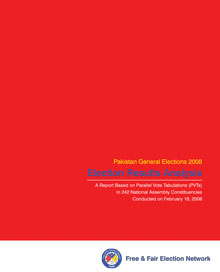
From June 13 to July 18, 2007, FAFEN conducted Pakistan’s first statistically valid audit of the Draft Electoral Roll (2007). FAFEN conducted a List-to-People and People-to-List audit in electoral areas covered by 506 randomly selected Display Centers throughout the country – a methodology that has been tried and tested in many other countries. These Display Centers were selected in 500 randomly chosen Union Councils according to proportion of population of each province.
In addition, FAFEN observed the quality of processes implemented by the Election Commission of Pakistan (ECP) Display Center Information Officers (DCIOs) in order to analyze their fairness, neutrality, and transparency, based on the ECP’s Manual of Instruction. FAFEN’s qualitative observation was conducted at about 21,000 (out of 45,000) Display Centers. Additionally, more
than 3,000 DCIOs and 25,400 people visiting the Display Centers were interviewed to gauge their perceptions about the processes inside the centers.
FAFEN also studied the activities of political parties and civil society organizations during the Display Period to analyze their level of interest in the process at more than 5,500 locations of the four provinces. A total of 754 FAFEN static and mobile observers, duly trained for their multifaceted tasks, were employed to carry out this research.
Key Findings
FAFEN’s key findings with regard to the accuracy and completeness of the 2007 Draft Electoral Roll were as follows:
a) A Quarter of Households were Not Registered
Almost 27 percent of households in the electoral areas covered were found to be not registered in the draft electoral roll. The highest number of unregistered households was found in NWFP at 45.53 percent. This was followed by Balochistan, with 41.22 percent; Islamabad at 37.5 percent; Punjab with 23.36 percent, and Sindh at 16.73 percent. The data extrapolation leads to an alarmingly high number of unregistered households in the country – around 5.3 million, basing on the national figure of a total of 19,849,770 households given by the ECP.
b) More Women than Men were Unregistered
The number of women not registered on the draft electoral rolls was much higher than the number of unregistered men throughout the country. However, there remained a high number of people who have not been registered on the electoral rolls, irrespective of their sex. The highest number of unregistered women was found in NWFP, at almost 50%. This percentage was followed by Sindh,
Punjab, and Islamabad. These women might not have been registered due to social obstacles to women’s political participation and the fact that many women lack CNICs.
c) Registered Households had Unregistered Members
Unregistered people, both males and females, were scattered all over the country and were part of households that had some members registered on the electoral roll. The finding was established by both List-to-People and People-to-List audits. Out of a total of 7,094 households checked during the List-to-People audit, only 3,875 (54.62 percent) of households were found to have the exact number of males as were on the list, while 2,847 (40.13 percent) of households had the exact number of females as were on the list.
d) The 2007 Electoral Roll was Largely Free of Entry-Level Errors
The two audits took into account the issue of the accuracy of the 2007 draft electoral roll with regard to the entries of names, addresses, and CNIC numbers of voters. The audit established that this new roll was largely free of the entry-level errors. More than 97 percent of respondents whose details were cross-checked were found to be accurate. The List-to-People and the People-to-List audit generated similar data regarding the accuracy of the electoral roll.

